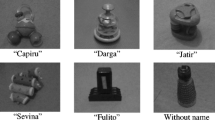Abstract
Four normally developing 2-year-old children were exposed to a story in which six novel characters appeared and were named. To assess learning of the character name → picture relations, all six pictures were presented together as comparisons in matching-to-sample test trials and the children were asked to make selections as each of the six names were dictated as samples. No child learned any of the target relations, but 2 made unreinforced conditional selections (URCSs) to some of the sample names (i.e., made their own one-to-one assignments of sample names to comparison pictures). This was the first time URCS had been demonstrated on an auditory-visual matching task, on any matching task with more than three comparisons, and with children so young. The long-term retention of a specific pattern of URCS was also shown for the first time, with 1 child maintaining his sample-comparison assignments across a 43-day gap in testing. The findings highlight the potential threat of URCS-based false-positives on tests of young children’s emergent matching-to-sample (e.g., in tests of stimulus equivalence or ostensive learning).
Similar content being viewed by others
References
BALDWIN, D. A. (1993). Infant’s ability to consult the speaker for clues to word reference. Journal of Child Language, 2, 395–418.
BOELENS, H. (1994). A traditional account of stimulus equivalence. The Psychological Record, 44, 587–605.
CATANIA, A. C. (1996). Natural contingencies in the creation of naming as a higher order behavior class. Journal of the Experimental Analysis of Behavior, 65, 276–279.
DOLLAGHAN, C. (1985). Child meets word: “Fast mapping” in preschool children. Journal of Speech and Hearing Research, 28, 449-454.
DUNHAM, P. J., DUNHAM, E, & CURWIN, A. (1993). Joint-attentional states and lexical acquisition at 18 months. Developmental Psychology, 29, 827–831.
GREEN, G. (1990). Differences in development of visual and auditory-visual equivalence relations. American Journal on Mental Retardation, 95, 260–270.
HARRISON, R. J., & GREEN, G. (1990). Development of conditional and equivalence relations without differential consequences. Journal of the Experimental Analysis of Behavior, 54, 225–237.
HAYES, S. C., & HAYES, L J. (1992). Verbal relations, cognition, and the evolution of behavior analysis. American Psychologist, 47, 1383–1395.
OVIATT, S. L. (1980). The emerging ability to comprehend language: An experimental approach. Child Development, 51, 97–106.
OVIATT, S. L. (1982). Inferring what words mean: Early development in infant’s comprehension of common object names. Child Development, 53, 274–277.
PILGRIM, C., & Galizio, M. (1990). Relations between baseline contingencies and equivalence probe performances. Journal of the Experimental Analysis of Behavior, 54, 213–224.
REYNELL, J. K. (1977). The Reynell developmental language scale (rev. ed.). London: N.F.E.R.
SAUNDERS, K. J., & SPRADLIN, J. E. (1990). Conditional discrimination in mentally retarded adults: The development of generalized skills. Journal of the Experimental Analysis of Behavior, 54, 239–250.
SAUNDERS, R. R., DRAKE, K. M., & SPRADLIN, J. E. (1999). Equivalence class establishment, expansion, and modification in preschool children. Journal of the Experimental Analysis of Behavior, 71, 195–214.
SAUNDERS, R. R., Saunders, K. J., Kirby, K. C., & Spradlin, J. E. (1988). The merger and development of equivalence classes by unreinforced conditional selection of comparison stimuli. Journal of the Experimental Analysis of Behavior, 50, 145–162.
SIDMAN, M. (1971). Reading and auditory-visual equivalences. Journal of Speech and Hearing Research, 14, 5–13.
SIDMAN, M. (1987). Two choices are not enough. Behavior Analysis, 22, 11–18.
SIDMAN, M. (1994). Equivalence relations and behavior: A research story. Boston, Ma: Authors Cooperative.
SIDMAN, M., & CRESSON, O., Jr. (1973). Reading and crossmodal transfer of stimulus equivalences in severe retardation. American Journal of Mental Deficiency, 77, 515–523.
SIDMAN, M., CRESSON, O., Jr., & Willson-Morris, M. (1974). Acquisition of matching to sample via mediated transfer. Journal of the Experimental Analysis of Behavior, 22, 261–273.
SIDMAN, M., & Tailby, W. (1982). Conditional discrimination vs. matching-to-sample: An expansion of the testing paradigm. Journal of the Experimental Analysis of Behavior, 37, 5–22.
SPRADLIN, J. E., COTTER, V. W., & BAXLEY, N. (1973). Establishing a conditional discrimination without direct training: A study of transfer with retarded adolescents. American Journal of Mental Deficiency, 77, 556–566.
WILLIAMS, D. C., SAUNDERS, K. J., SAUNDERS, R. R, & SPRADLIN, J. E. (1995). Unreinforced conditional selection within three-choice conditional discriminations. The Psychological Record, 45, 613–627.
WOODWARD, A. L., MARKMAN, E. M., & FITZSIMMONS, O M. (1994). Rapid word learning in 13- and 18-month-olds. Developmental Psychology, 30, 553–566.
YAMAMOTO, J., & ASANO, T. (1995). Stimulus equivalence in a chimpanzee (Pan troglodytes). The Psychological Record, 45, 3–21.
Author information
Authors and Affiliations
Corresponding author
Rights and permissions
About this article
Cite this article
Dugdale, N., Johnson, S. Unreinforced Conditional Selection by Two-Year-Olds in A Six-Comparison Matching Task. Psychol Rec 52, 159–172 (2002). https://doi.org/10.1007/BF03395421
Published:
Issue Date:
DOI: https://doi.org/10.1007/BF03395421




